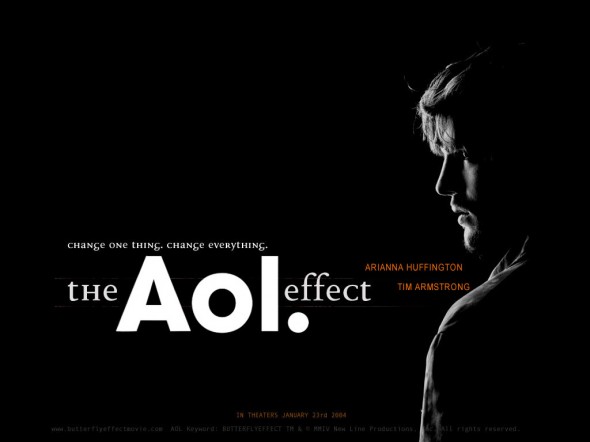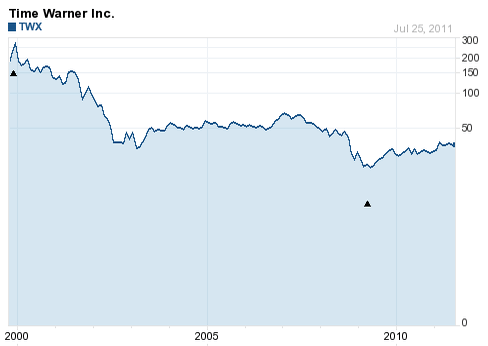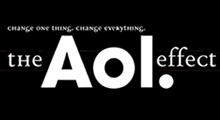
AOL made its name in the early days of dial-up internet by sending out free connection CDs with every magazine under the sun, and providing a nice walled garden web experience for those just tarting out on the internet. These legacy subscribers are still the main source of revenue for the company but they have tried numerous other options in attempts to bolster their ever-declining revenues.
They first had a disastrous nine-year merger with Time Warner – in which the two companies never really made use of their massive market penetration and link up between technology and media/entertainment. They could have built a Hulu or a Spotify and brought traditional media to embrace technology almost a full decade before others managed to do so. But they didn’t – they dragged their feet as only huge corporations can, and completely missed the boat on any innovation.
Then AOL saw the profits being generated by innovating online advertising companies around 2004 and pivoted into focusing on dominating web advertising, both on its growing list of individual wholly owned (and recently purchased) sites such as Engadget, Moviefone and representing external sites with its acquisition of Advertising.com. They created Platform-A, and built upon it with the acquisitions of Adtech and Tacoda, well-positioning themselves for providing both the technology to target and serve ads and the sales team and web properties to represent. However, with the economic downturn towards the end of the decade, having such a strong focus on advertising was to AOL’s detriment and Time Warner spun out the company again in 2009. (See chart of history AOL Time Warner share price)

Rather than focus on what they were doing well and attempt to weather the storm AOL has again been on a buying spree, firstly TechCrunch – the infamous technology and start-up blog from Michael Arrington and team, and then more notably the Huffington Post. Since the AOL purchase of TechCrunch, the site has expanded its output but has shifted focus away from emerging startups and disruptors both online and off, to become closer to a technology and gadget gossip blog like pageview-rich stablemate Engadget. From a blog that often led the mainstream press on discovering new start-ups in Silicon Valley and elsewhere – they now seem happy to republish press releases and quote unverifiable statistics from unnamed sources. This could have something to do with the rebundling of other TechCrunch network sites such as CrunchGear into the main site – but it does all reflect a lack of focus.
Such a lack of focus is something that AOL in general has continually suffered from as the conglomerate has lurched from idea to idea after the ships had sailed. Growing by acquisition can work very well for companies, and AOL has acquired some leading sites and services – but they rarely seem to have changed the culture at the top, where they are scrabbling for cash to make up for their dwindling internet subscriber base. The purchase of The Huffington Post was, then, a big change for the whole make-up of the company. AOL was essentially attempting to increase pageviews of its web properties whilst at the same time drastically reducing the number of paid staff for those sites. Indeed, AOL fired a huge number of employees and most freelancers in March as part of their “restructuring”.
The restructuring may have made sense from a business perspective, and if a company is haemorrhaging money the way AOL was, people did need to go. The way the staff were let go has caused widespread outrage, but that is not the important point from my perspective. No, it was how AOL were firing paid staff, only to ask them back as unpaid bloggers or getting other unpaid bloggers to fill their content creating roles. AOL has decided that many of the content sites and blogs they have acquired over the previous decade should now be run by unpaid bloggers in-line with the huge volume of content created by the Huffington Post. In a few short years AOL has forgotten whey these sites such as movie blog Cinematical have been popular – it is the content written by its staff. Their popularity was developed over the years by committed staff (sometimes for financial reward and sometimes not) offering critical and independent thinking.
Yes valuable brands are developed online by independent voices, but those brands are only valuable so long as they are invested in. To role up a collection of blogs in a content group as columns under another site, and without the same well respected independent voices behind those columns basically defeats the point of those brands in the first place. If people want celebrity and political gossip then they may well go to the Huffington Post, but for quality reviews and analysis you may well go elsewhere. To remove the quality content producers, and belittle the brands they created – AOL has started not just haemorrhaging money, but also the value of each of its independent properties. The multitude of quality independent voices that they acquired, are quickly becoming replaced by the mediocre but pageview-grabbing voices created by crowd-sourcing. AOL have pivoted again, but this time to compete with Demand Media and other content farms – something we could all do without.


Pingback: AOL Share Price Plummets After 2nd Quarter Results And Board Announces Buy Back | TechFruit